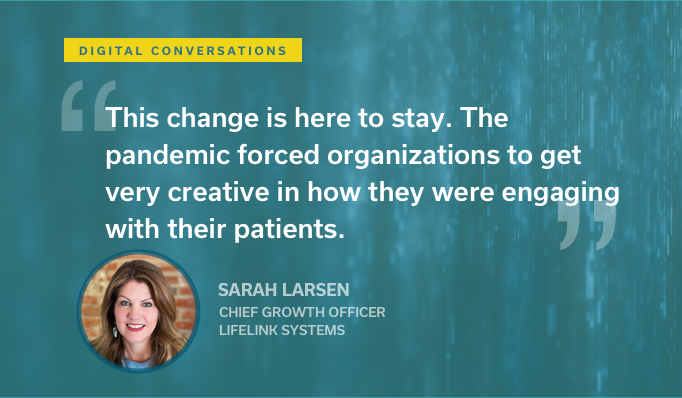At the peak of the COVID-19 pandemic, companies innovated to turn their businesses contactless. Take Best Buy, for example. With its contactless curbside pickup, you could place orders online and park in a preassigned space at a specific store location. Once you’re there, you can pop your trunk and someone would come load the purchase directly into your car. No lines, no human contact, no hassle. This foreign concept before 2020, but has become a standard aspect of retail business today.
Across industries, companies are meeting customers where they are: in their homes, and in their smartphones. Gyms are turning their classes virtual through apps, with 80% growth in fitness app downloads in the recent months. UberEats has seen a 30% surge in customer signups, with the number of deliveries soaring. Pharmacies like CVS are offering free home delivery for prescriptions.
Though consumers are grew restless at home while quarantined during teh pandemic, it’s hard to imagine giving up many of these fast, easy experiences. There’s good evidence that consumers are getting used to these digital store experiences and will continue to use them even after the pandemic is history. 50% of consumers report a significantly increased willingness to permanently purchase their groceries online. The coronavirus has also converted more Baby Boomers into online shoppers, with 86% of 61+ year olds reporting usage of ecommerce sites to avoid in-person shopping experiences (up 50%+). It’s highly likely that this shift will be permanent, even as we transition to a post-pandemic life.
Hospitals have a significant opportunity to follow the ‘new normal’ consumer experiences that the retail and service industries introduced during the COVID pandemic.
When we pivot to look at the healthcare industry, it’s clear hospitals have a significant opportunity to follow the ‘new normal’ experiences that the retail and service industries have introduced. When hospitals were at the epicenter of the COVID-19 pandemic, patients were understandably fearful of in-person visits necessary to get the care they need.
In fact, 38% of patients are opted to delay or avoid care altogether for heart symptoms, as evidenced by the drop in treatment occurrences compared to pre-pandemic baselines. Patients that desperately needed care chose to delay visiting hospitals to avoid getting infected. During the first year of the Covid pandemic, patients missed around 10M potentially life-saving cancer screenings.
Retail, restaurants, and banking have all gone virtual. Hospitals also need to expand the tools and services that were put in place to make patients feel safe during the pandemic and pivot towards delivering premium consumer-centric digital experiences.
But with healthcare staff already overworked, operational efficiency is at a premium. Hospital systems are trying to educate patients, conduct intake, and check them in over the phone, but Patient Access and Medical Assistant teams don’t have time to leave voicemails and play phone tag with patients who don’t pick up their phones. How can hospital systems deliver safe, patient-friendly encounter experiences without burdening care teams?
To solve this problem, hospitals must embrace virtual interactions. Business meetings, cooking classes, and high school graduations have all gone virtual. It’s time for the waiting room to go virtual as well.
A traditional waiting room crams patient education, intake, and check in all into the 20 minutes before a patient’s visit. Whether the doctor is running early, on time, or late, patients must arrive early to ensure they are prepared for their appointment. If hospitals can expand the waiting room to the comfort of the patient’s home, starting from the moment they scheduled the visit, all the way to walking into the exam room, patients would be able to prepare for their appointments and fill out their forms whenever is most convenient for them, only showing up at the clinic when the doctor is ready to see them. Who wouldn’t want to get ready for their appointment at home, on the couch, instead of scribbling through paper forms in a stressful, crowded waiting room?
It’s not just better for patients, it’s also better for care teams.
Relieving patient populations of tens of thousands of hours every year in in-person waits is a powerful value opportunity for providers. It’s not just better for patients, it’s also better for care teams. Virtual waiting rooms that automate patient education, intake, and check in free up Patient Access and Medical Assistant teams from managing loads of paperwork and playing phone tag. The payoff can be huge — hospital systems can literally save millions of dollars a year.
To pull this off, hospital systems will need to deploy smart, automated solutions that integrate to their backend EMR and practice management systems. Personalized digital assistants that use advanced Conversational AI technology to understand patients’ appointment schedules, how to prepare patients for their visits, and collect necessary intake forms, can deliver an efficient, intuitive process that makes it easy for patients to get ready for their visits on their own, all before even stepping foot in the hospital. Equipping overworked care teams with automated digital assistants that can handle hundreds or thousands of FAQ, intake, and check in conversations at once can free up staff to focus on providing care, all while improving patient experience and satisfaction.
This pandemic won’t be a permanent fixture in our lives, but its impact on customer service and the healthcare industry can be. Virtual waiting rooms can extend the waiting room beyond the four walls of a hospital and beyond the few hours a patient has to spend sitting in a hospital lobby. The hospital waiting room is now on-demand and on-the-go, the way it should be.








